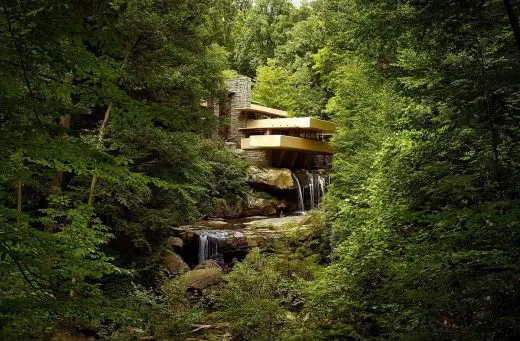The organic architecture of Frank Lloyd Wright, FLW building design theory, 20C furniture and fixtures
The Organic Architecture of Frank Lloyd Wright
June 24, 2024
Frank Lloyd Wright, an icon in the realm of architecture, revolutionized the way we perceive and construct buildings. His pioneering concept of organic architecture emphasized harmony between human habitation and the natural world.
Wright’s designs weren’t merely structures; they were living, breathing entities that blended seamlessly with their environments. This article delves into the essence of Wright’s organic architecture and its lasting impact on modern design.
Defining Organic Architecture
Organic architecture is a philosophy of architecture which promotes harmony between human habitation and the natural world. This is achieved through design approaches that are sympathetic and well-integrated with a site, so buildings, furnishings, and surroundings become part of a unified, interrelated composition. Wright believed that architecture should not be an imposition on the landscape but rather a product of it.
Wright’s Principles of Organic Architecture
Wright’s principles included the use of natural materials, harmony with the environment, and a sense of continuity between the interior and exterior of the building. His designs often featured open floor plans, large windows, and a strong emphasis on the horizontal line, which echoed the expansive American landscape.
Interior Design and Functionality
The interior of the Robie House is as impressive as its exterior. Wright designed the furniture and fixtures to complement the overall architectural style. The open floor plan enhances the sense of space and light, while large windows provide ample natural light and views of the surrounding landscape. The thoughtful placement of rooms ensures privacy and functionality, embodying Wright’s belief that form and function should be harmoniously balanced.
The Influence of Wright’s Organic Architecture Today
Modern Interpretations and Sustainability
Wright’s ideas have had a lasting influence on contemporary architecture. Modern architects continue to draw inspiration from his principles of sustainability and harmony with nature. Today, the integration of natural elements in design and the use of sustainable materials are seen as essential components of environmentally responsible architecture.
Green Building Practices
Many of Wright’s principles are now considered fundamental to green building practices. The use of local materials, energy-efficient designs, and integration with the surrounding landscape are all strategies that modern architects employ to create sustainable buildings. Wright’s work serves as a blueprint for designing structures that are in harmony with their environment, reducing their ecological footprint while enhancing the quality of life for their occupants.
The Intersection of Technology and Nature
In the digital age, the concept of organic architecture has evolved. Technologies such as the mrbeast casino app highlight how digital interfaces can blend seamlessly with user experiences, much like Wright’s architecture blended with its environment. Just as Wright’s designs aimed to create a natural flow between indoor and outdoor spaces, contemporary digital applications aim to create a seamless user experience that feels natural and intuitive.
Integrating Technology into Design
Modern architects are increasingly integrating technology into their designs to enhance functionality and user experience. Smart home systems, energy management technologies, and advanced materials are now part of the architectural landscape. These innovations reflect Wright’s vision of creating environments that are not only aesthetically pleasing but also highly functional and responsive to the needs of their inhabitants.
Wright’s Legacy: A Blueprint for the Future
Preserving Wright’s work and educating new generations about his principles is crucial for maintaining his legacy. Many of his buildings are now museums or educational centers, providing insight into his philosophy and design process. Organizations like the Frank Lloyd Wright Foundation continue to advocate for the preservation and appreciation of his work.
The Role of Preservation Organizations
Preservation organizations play a vital role in maintaining Wright’s legacy. They ensure that his buildings are preserved and restored according to his original vision. These organizations also educate the public about Wright’s contributions to architecture and his innovative ideas. By supporting these efforts, we can ensure that future generations continue to learn from and be inspired by Wright’s work.
Inspiring Future Architects
Wright’s emphasis on sustainability and harmony with nature continues to inspire architects today. As the world grapples with environmental challenges, Wright’s principles offer valuable lessons on how to create buildings that are not only aesthetically pleasing but also environmentally responsible.
The Future of Organic Architecture
The future of organic architecture lies in its ability to adapt to changing environmental conditions and technological advancements. Wright’s principles provide a foundation for creating buildings that are resilient, sustainable, and in harmony with their surroundings. By embracing these principles, future architects can design structures that contribute to a healthier and more sustainable world.
FLW Archiecture Design – Conclusion
Frank Lloyd Wright’s organic architecture remains a cornerstone of modern design. His visionary approach to integrating buildings with their natural surroundings continues to influence architects and designers. By adhering to principles of sustainability and harmony, Wright’s legacy offers a blueprint for creating spaces that are both beautiful and environmentally conscious.
Whether through iconic structures like Fallingwater or the innovative use of technology, the essence of Wright’s philosophy endures. As we look to the future, embracing Wright’s principles may be key to creating a more harmonious and sustainable built environment.
By blending Frank Lloyd Wright’s architectural philosophy with contemporary digital innovations, this article provides a comprehensive look at the enduring impact of his work. The inclusion of the “mrbeast casino app” demonstrates how modern technology can align with Wright’s vision of seamless integration and user-centric design.
Comments on this guide to The Organic Architecture of Frank Lloyd Wright article are welcome
American Architecture Designs
American Architectural Designs – recent selection from e-architect:
America Architecture News – latest building updates
Property Design
Contemporary Property Designs – recent architectural selection from e-architect below:
Comments / photos for the The Organic Architecture of Frank Lloyd Wright page welcome.






